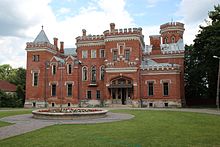Eugenia Maximilianowna von Leuchtenberg
Princess Eugenia Maximilianowna of Leuchtenberg ( Russian Евгения Максимилиановна Лейхтенбергская , also known as Princess Yevgenia Romanovskaya born March 20, jul. / April 1, 1845 greg. In St. Petersburg, † April 21 jul. / May 4, 1925 greg. In Biarritz ) was the youngest daughter of Maximilian de Beauharnais , 3rd Duke of Leuchtenberg and his wife, Grand Duchess Maria Nikolajewna Romanowa . By marriage she was a princess of Oldenburg . As a member of the imperial family, she also performed representative tasks.
Family and marriage
Two years after the death of her father, Duke Maximilian, her mother married Count Gregori Alexandrowitsch Stroganow . The marriage was morganatic and concluded without the consent of the Tsar. Maria then had to go into exile. However, her children stayed with the family in St. Petersburg, where she grew up with her siblings in the Mariinsky Palace .
Among other things, Eugenia was considered a potential candidate for marriage to the Catholic Prince Ludwig of Bavaria . After his uncle Otto abdicated as King of Greece , Ludwig was considered a Wittelsbach contender for the Greek throne in the event of a restoration . A wife of Orthodox faith would have benefited this project. The crown princes of Italy and Denmark Umberto and Frederick were also considered potential marriage candidates. However, neither the restoration nor the marriage plans were put into practice.
On January 19, 1868, Eugenia instead married her second cousin Alexander von Oldenburg , son of Peter von Oldenburg and brother of Grand Duchess Alexandra Petrovna . As the grandson of a tsar, like Eugenia, he was part of the imperial family and an Imperial Highness and grew up in Russia. Eugenia's brother Georg Alexander later married his younger sister Therese .
Their only child Peter married Grand Duchess Olga Alexandrovna , sister of Tsar Nicholas II , in 1901. However, the marriage was annulled in 1916 because of Peter's apparent homosexuality .
Next life
Eugenia's uncle Tsar Alexander II gave the couple a piece of land in the village of Ramon in 1879 , where they had a Tudor-style castle built. Despite great commitment in the area and for the workers of the sugar refinery operated by the couple , they stormed the property in 1902 as part of general unrest and caused serious damage to the house. It was later confiscated by the Bolsheviks and used, among other things, as a school and accommodation for the factory workers.
The couple were very involved socially and culturally and invested a large part of their wealth in good causes. So it founded the Oldenburg Institute, which had the task of technical education of boys and girls. Eugenia was also chairwoman of the Imperial Society for the Promotion of the Arts.
After the Russian-supported coup of 1886 against Prince Alexander I of Bulgaria , Alexander von Oldenburg, supported by his cousin Tsar Alexander III. , briefly as a candidate for the Bulgarian throne, so that Eugenia would have become Princess of Bulgaria at his side. The Berlin Treaty of 1878, however, said that no member of a large ruling house should become the new sovereign of Bulgaria and that this should be elected by the people. The other European powers wanted to prevent further influence of Russia in the Balkans, to whose ruling house Alexander was due to his family connections. It was finally decided in favor of the Austro-French Prince Ferdinand von Sachsen-Coburg-Gotha .
Revolution and exile
The February Revolution of 1917 and the end of the monarchy. Ramon Castle and the family's Petersburg palace were confiscated by the Kerensky government and the family fled to Finland from where they emigrated to France in 1922 . Unlike most of the other members of the imperial family, the Oldenburgs were allowed to take most of their valuables with them so that they could lead a reasonably comfortable life in exile. Eugenia died in Biarritz in 1925. Her husband survived her by seven years. Both were buried on the Cimetière du Sabaou.
Web links
Individual evidence
- ↑ Edouard Driault: Histoire Diplomatique de la Grece de 1821 a nos jours. Les Presses Universitaires de France, 1825, accessed December 15, 2015 (French).
- ↑ Foreign Items. The New York Times, November 28, 1863, accessed January 15, 2016 .
- ↑ Foreign Items. The New York Times, July 16, 1865, accessed January 15, 2016 .
- ↑ Foreign Items. The New York Times, December 31, 1865, accessed January 15, 2016 .
- ^ The Distress in Russia - Enterprises for the Future. The New York Times, January 23, 1892, accessed January 15, 2016 .
- ↑ Russian Mob Burns Down Another Chateau. The New York Times, May 2, 1902, accessed December 24, 2015 .
- ^ Princess a philanthropist. The Washington Post, February 13, 1907, accessed January 15, 2016 .
- ^ Alexander of Oldenburg - Berlin Letter to the London Daily News. The New York Times, October 3, 1886, accessed January 15, 2016 .
- ^ The Peerage. Retrieved January 15, 2016 .
| personal data | |
|---|---|
| SURNAME | Leuchtenberg, Eugenia Maximilianowna from |
| ALTERNATIVE NAMES | Romanovskaya, Yevgenia; Лейхтенбергская, Евгения Максимилиановна (Russian) |
| BRIEF DESCRIPTION | youngest daughter of Maximilian de Beauharnais, 3rd Duke of Leuchtenberg and his wife Grand Duchess Maria Nikolajewna Romanowa |
| DATE OF BIRTH | April 1, 1845 |
| PLACE OF BIRTH | St. Petersburg |
| DATE OF DEATH | May 4, 1925 |
| Place of death | Biarritz |


